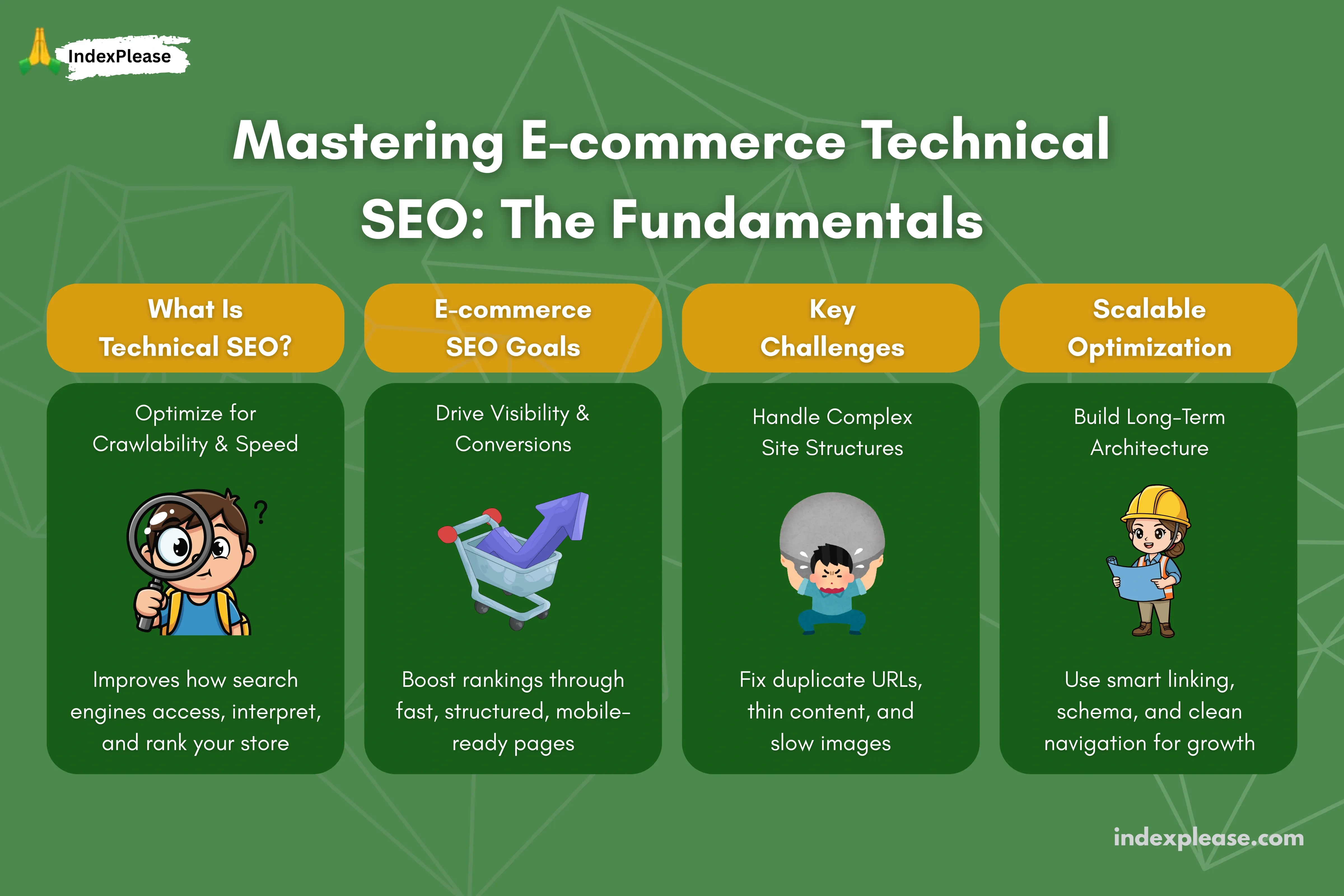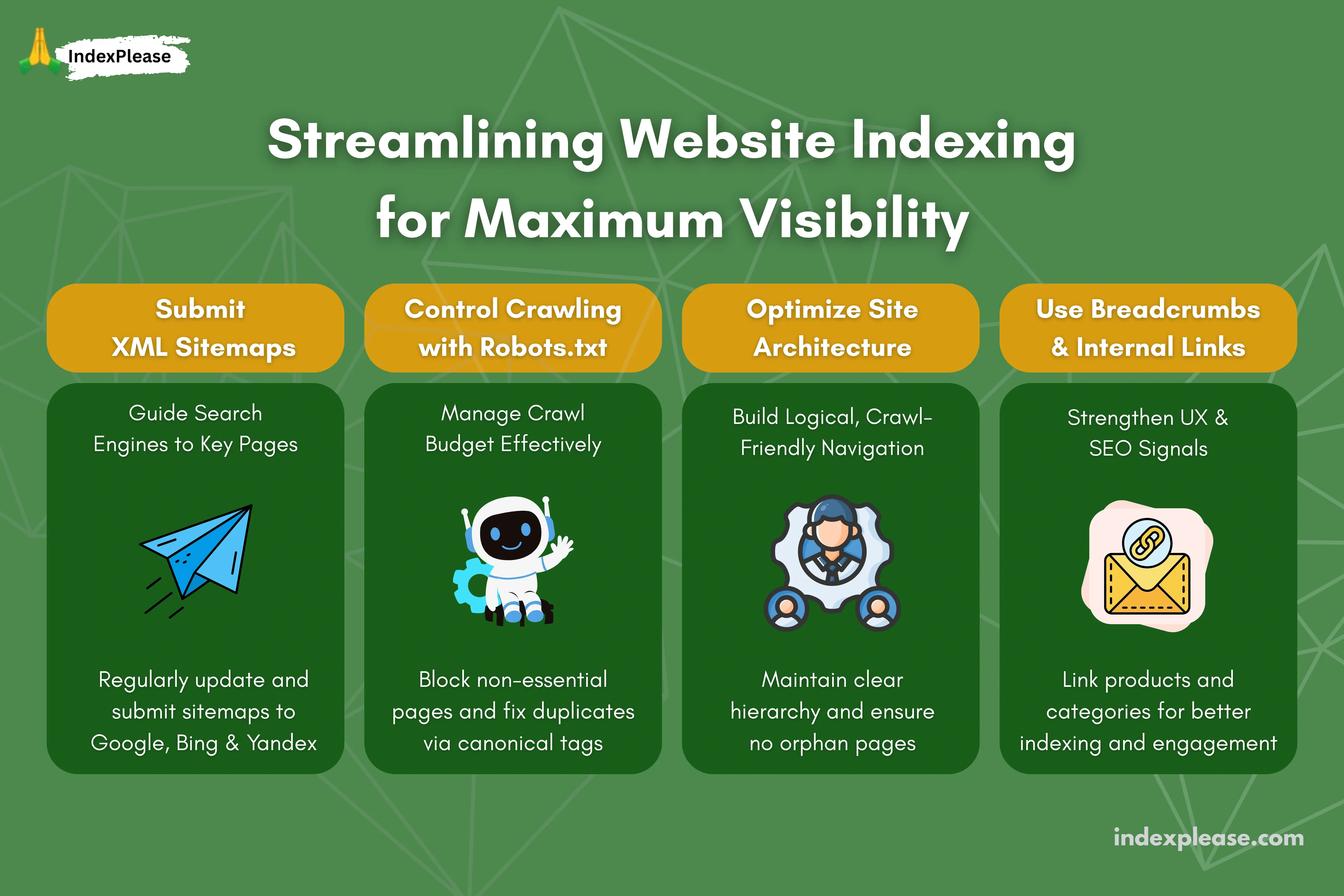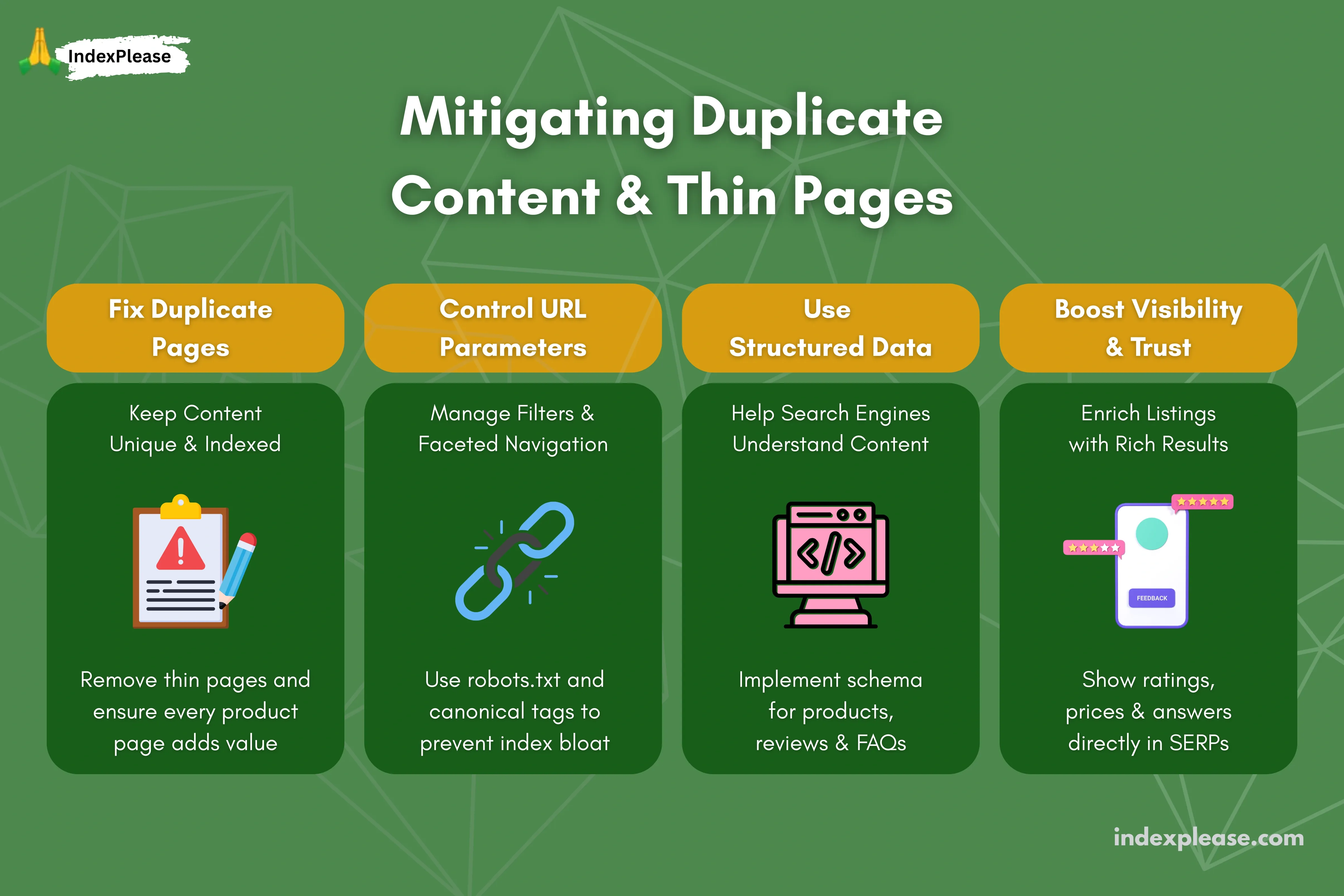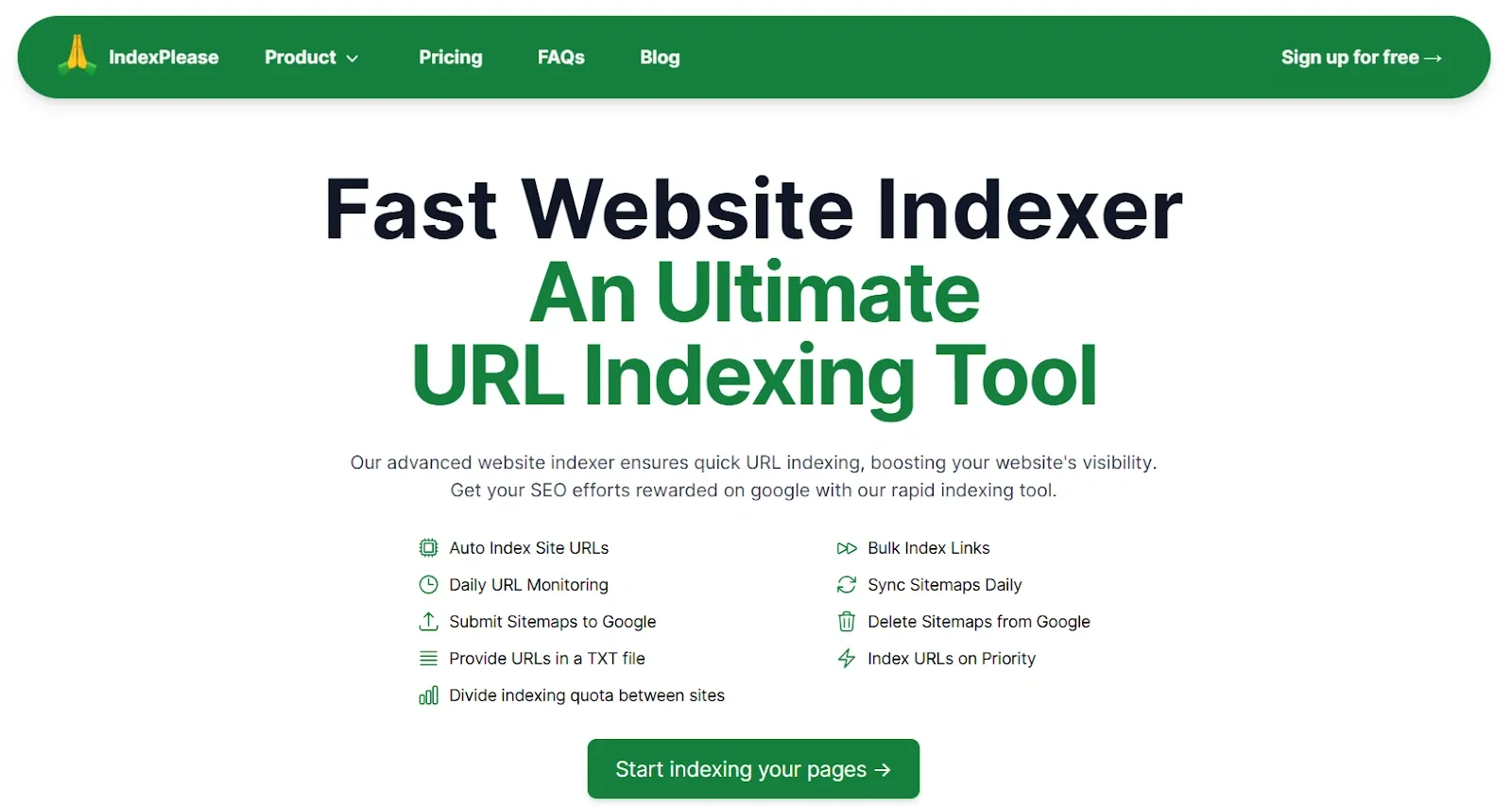
Unleash your online store’s full potential: leverage potent technical SEO strategies
Most online shopping starts with a search engine.
Without strong technical SEO, your e-commerce store risks poor discoverability, indexing issues and lost revenue.
This guide provides advanced technical SEO strategies, focusing on crawlability, site architecture and on-page optimization, to deliver measurable results quickly.
Mastering E-commerce technical SEO: The fundamentals

Optimizing e-commerce websites for search engines presents unique challenges.
Implementing strong technical SEO is crucial for product discoverability, scalable site architecture and a seamless user experience across all devices. D2C brands and digital agencies can significantly boost organic rankings and revenue through technical SEO.
Defining technical SEO for online stores
Technical SEO optimizes e-commerce sites for search engines by improving crawlability, indexing, speed, mobile responsiveness and structured data.
This enables search engines to efficiently access, interpret and rank product pages, connecting stores with customers.
The unique SEO challenges E-commerce brands face
E-commerce businesses often face technical SEO challenges like duplicate content, confusing navigation, thin product pages, faceted navigation, inventory turnover and slow images. For instance, an electronics retailer might create redundant URLs with numerous filter options, hurting SEO.
Proactive planning and specific technical tools are essential for large online stores to address these issues.
Streamlining website indexing for maximum visibility

Top search visibility needs efficient website indexing.
D2C founders, SEO professionals and digital marketing agencies must understand search engine guidelines to boost organic rankings.
Solutions like IndexPlease help brands achieve quicker, broader indexing across Google, Bing, Yandex and AI search engines.
Submitting and optimizing XML sitemaps for Google, Bing and Yandex
XML sitemaps direct search engines to key pages for indexing.
Submit yours to Google Search Console, Bing Webmaster Tools and Yandex.Webmaster. Optimize by regularly updating, removing low-value URLs and ensuring proper formatting.
Leveraging Robots.txt and canonical tags to guide crawlers
Robots.txt and canonical tags are crucial for SEO.
Robots.txt stops crawling of non-essential pages, saving crawl budget. Canonical tags fix duplicate content by identifying the preferred URL, consolidating ranking signals.
One client achieved an 80% reduction in duplicate content issues after optimizing these, improving crawling and indexing.
Optimizing site architecture and navigation
Good site architecture helps search engines find and index e-commerce pages easily.
Establish a logical category hierarchy, preventing orphaned pages. Ensure important content is easily accessible from the homepage to boost crawl rates.
Implementing breadcrumb navigation and internal linking best practices
Breadcrumb navigation and strategic internal linking improve user experience and SEO.
Breadcrumbs, mirroring site hierarchy, help users and crawlers. Internal links, like connecting top products to category pages, increase session durations, proving their SEO and UX value.
Enhancing core web vitals and mobile experience

Optimizing Core Web Vitals and mobile experience is crucial for e-commerce sites.
Core Web Vitals, measuring speed, interactivity and stability, are direct ranking signals, improving user experience, conversions and search rankings.
Prioritising speed, mobile responsiveness and user engagement metrics
Enhance site speed and mobile responsiveness to boost user engagement and reduce bounce rates.
Use tools like mobile-friendly testing and PageSpeed Insights to identify issues. Implement responsive design and optimized images for seamless viewing and intuitive CTAs for deeper engagement.
Technical fixes for reducing site load times and improving accessibility
Improve technical aspects like image optimization, CSS/JavaScript minimization and browser caching for faster load times.
Implement lazy loading and ensure mobile readability, plus ARIA labels for accessibility. These fixes have boosted e-commerce conversion rates by up to 15% due to improved page speed and ease of shopping.
Mitigating duplicate content and thin pages

Duplicate content and thin product pages hurt e-commerce SEO.
D2C founders, SEOs and marketing agencies must ensure unique, properly indexed product pages.
Managing parameterized URLs and faceted navigation
Parameter-based URLs from product filters or sorting options often create numerous near-duplicate pages.
Map URL variations and guide search engines with robots.txt rules and canonical tags. The best e-commerce brands make sure their most important pages are optimized for search engines.
This helps search engines crawl them better, keeps index bloat down and maintains strong rankings.
Leveraging structured data and advanced schema markup
Implementing structured data and advanced schema markup is crucial for e-commerce sites to dominate organic search.
Structured data helps search engines understand, index and present online content richly, boosting click-through rates.
Utilizing appropriate schema and robust audit tools allows e-commerce brands to maximize visibility across all search platforms.
Applying product, review and FAQ schema to boost rich results
You can make your search listings shine by adding product, review and FAQ schema.
This means showing off pricing, stock, images, ratings and answers to common questions right in the search results.
Boost customer trust and decision-making; apply schemas correctly for increased engagement.
Troubleshooting common schema errors for E-commerce

Outdated or misconfigured schema can prevent rich results or lead to penalties.
Regularly monitor Google Search Console and validation tools for errors like missing properties or inconsistent data.
Quickly update schema to current specifications, accurately marking up each product or content type. This vigilance ensures reliable rich results and avoids missed opportunities in SERP features.
IndexPlease: Automating your indexing for speed and visibility

IndexPlease optimizes e-commerce content indexing on Google, Bing, Yandex and AI search platforms.
IndexPlease automates indexing, boosting brands, SEO professionals and digital marketing agencies’ visibility for product pages and website content.
Expedited indexing allows search engines to swiftly discover new products and updates, thereby boosting organic traffic and accelerating content visibility in search results.
Final thoughts
Boost e-commerce visibility and growth by optimizing crawlability, refining site architecture, enhancing Core Web Vitals and effectively utilizing structured data.
By prioritizing technical SEO, your online store can significantly improve its visibility to search engines. This helps more people find and understand your products, leading to higher rankings and more sales.
Tools like IndexPlease streamline this process, ensuring your content is rapidly and effectively indexed across all major search platforms.
FAQs
What is technical SEO for online stores?
Technical SEO optimizes e-commerce sites for search engines by improving crawlability, indexing, speed, mobile responsiveness and structured data, ultimately boosting product page ranking.
Why is strong technical SEO crucial for e-commerce?
Poor technical SEO hides e-commerce stores, creating indexing problems and lost revenue as customers can’t find products.
What are common technical SEO challenges faced by e-commerce brands?
E-commerce businesses frequently encounter challenges like duplicate content, poor navigation, thin product pages, faceted navigation, inventory turnover and slow images.
How do XML sitemaps help with search visibility?
XML sitemaps direct search engines to crucial pages for indexing. Submitting and optimizing them via Google Search Console, Bing Webmaster Tools and Yandex.Webmaster improves crawling efficiency.
What role do Robots.txt and canonical tags play in SEO?
Robots.txt saves crawl budget by blocking non-essential pages, while canonical tags consolidate ranking signals by resolving duplicate content.
How can site architecture and navigation be optimized?
Effective site architecture organizes categories logically, links all pages and ensures easy homepage access, improving crawlability.
What are the benefits of breadcrumb navigation and internal linking?
Breadcrumb navigation and internal linking enhance user experience and SEO by reflecting site hierarchy and connecting products, boosting session durations.
Why are Core Web Vitals important for e-commerce?
Core Web Vitals directly impact e-commerce site rankings, user experience and conversions by measuring speed, interactivity and stability.
How can site load times and accessibility be improved?
Technical fixes like image optimization, CSS/JavaScript minimization, browser caching, lazy loading, mobile readability and ARIA labels can significantly boost conversion rates.
How can duplicate content and thin pages be mitigated?
Effectively manage parameterized URLs with robots.txt and canonical tags. Ensure unique, properly indexed product pages to prevent SEO damage.
How can common schema errors be troubleshooted?
Monitor Google Search Console for errors and update schema promptly for accurate rich results.
How does keyword analysis benefit e-commerce SEO?
Targeting high-intent, long-tail, seasonal and niche keywords attracts buyers and boosts conversions by meeting specific audience needs.
How does IndexPlease help e-commerce businesses?
IndexPlease enhances online visibility for D2C brands, SEO professionals and digital marketing agencies. It automates indexing, ensuring search engines quickly recognize new product pages and content.